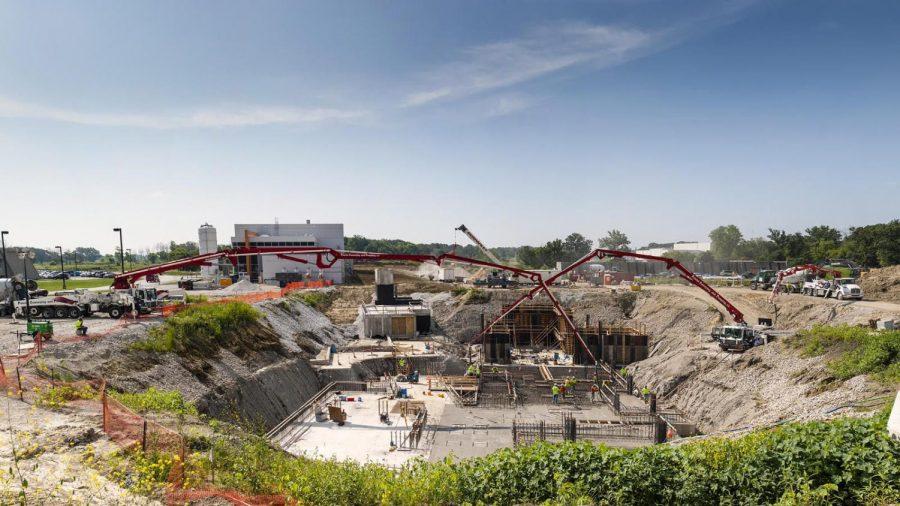Q&A: Professor awaits experiment that could tell secrets of universe
November 4, 2015
NIU physics professor David Hedin’s eyes lit up as he talked about the $270 million federally funded muon to electron (Mu2e) experiment.
A muon is a subatomic particle that is similar to the electron, but 200 times heavier, and was discovered 80 years ago. Hedin said the goal of a particle physicist is to understand the relationship of extra particles, such as muons, and regular particles, such as electrons.
Hedin and a team of three NIU professors, students, Fermilab personnel and more than 32 institutions have been preparing an experiment to turn a muon into an electron – a rare scenario, Hedin said – since 2000. If successful, physicists will know more about the first instances of muons turning into electrons.
“One of the reasons I do this research is I’m actually sort of fascinated about why we exist,” Hedin said.
A building being constructed at Fermilab to conduct the experiment will be finished ideally by 2019, Hedin said.
Q: Can you give a laymen’s explanation of the Mu2e project?
A: Sure. You know what an electron is, right? Well, it turns out a muon is an electrons heavier cousin. Muons are actually quite common. Muons produced in the upper atmosphere are going through your body about every second; about one third of the naturally occurring radiation that you get per year is coming from these muons. The muon was the first extra particle that was discovered about 80 years ago. So it turns out our universe has all these extra particles.
In my lifetime as a physicist, we’ve learned that these extra particles were important at the beginning of the universe which allow us to exist. The extra particles mingle with the regular particles and the process of that mingling allows particles to exist here. If not, our universe would be completely empty. So what particle physicists do is look at these extra particles and try to understand the relationships.
While the muon was the first one to be discovered 80 years ago, we’ve returned to it in the last 10 years to try to do very, very sensitive experiments looking at its properties. One of which is, ‘Can a muon turn into an electron?’ So that’s what the Mu2e experiment is doing is looking for a very, very rare 10 to the negative 17 probability of a muon turning into an electron. And if that happens, it may be pointing to what happened in the first instant of the universe where these changes would have occurred.
Q: What’s happening now with Mu2e?
A: We’re in the process of getting approval each year. We’re a line item in the federal budget. So how much money we get depends on Congress passing [our budget].
Our building is in the process of being built. In the meantime, we are starting to order all the parts for the detector system like things that will measure the particles going through the detector in order for us to look for the muon to electron conversion.
Q: How are NIU students involved?
A: In designing this building, there is an awful lot of background radiation from neutrons and gamma rays, so we’ve had a number of students run what’s called monte carlo programs, and they are used to estimate the background and then to cleverly put shielding – big blocks of concrete or big blocks of heavy concrete – in certain regions in order to shield the detector elements from this background radiation. It turns out this experiment has $8 million worth of concrete in these blocks. Putting them in the right spot and optimizing requires a lot of programing.
They also help design and test various detector elements. They allow use to detect the passage of charged particles. We haven’t gone to mass production yet, we’re still doing prototyping. We’ve been doing that in collaboration with Fermilab and the University of Virginia.
We’ve had engineering students who’ve worked on the mechanical design of some of these elements. Their job is to make sure the elements can support the weight and can be installed. You can’t go to Lowe’s and buy a detector off the shelf; you have to design everything.
Q: What do you expect out of the Mu2E?
A: Well, our hope is that we will see the direct conversion of muons to electrons. No one has ever seen it, but there are various models that predict that we should see them. If we saw an effect, then that would be pointing us to what really is the underlying theory of everything. We know something is there, we just don’t know what.
Q: What will the experiment look like?
A: We measure these muon conversions by taking a muon and stopping it in aluminum. That causes the muon to actually interact with the aluminum nuclei. If we see an effect, then you can actually tell the difference between different items by stopping the muon in gold or tin. We can then do a series of experiments using different nuclei to increase or decrease the various types of physics that could be causing this change.







